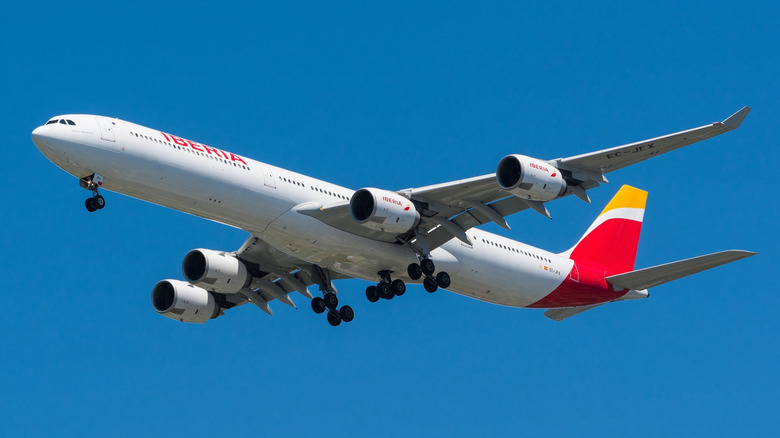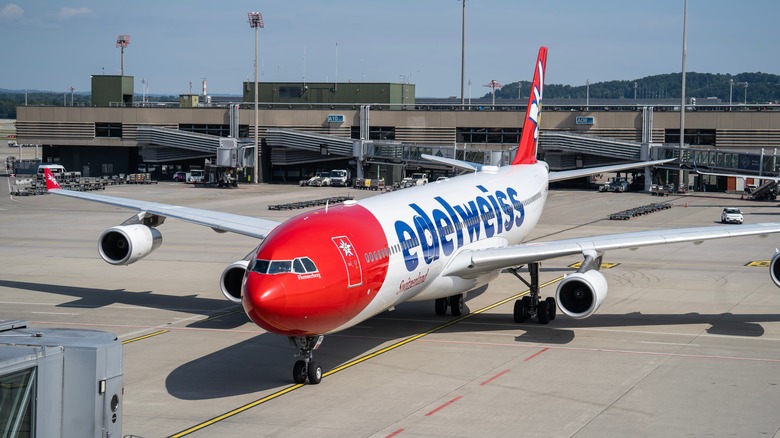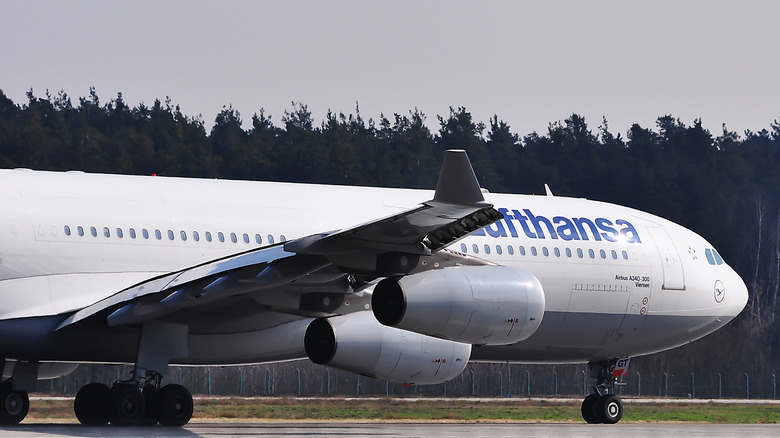Why The Airbus A340 Commercial Jet Has Such Tiny Engines
For years, Airbus has dominated the commercial aircraft space alongside Boeing, offering flight options for both freight and passengers. As you might expect, the company has an impressive catalog of planes, some of which, like the chin-bumped A330 Freighter, have modifications that allow them to shine in their respective niches.
Many of the changes the company makes to its crafts come with good reason, as seen in the Airbus A340, which features four small engines as opposed to two massive ones, unlike its sibling, the A330. The reason behind this design is quite simple. The market over in the Asia-Pacific region felt more comfortable with four engines rather than two, which is more popular with North American companies. The increased number of engines is to mitigate any danger that might come in the event of an airborne engine failure, especially during a long flight over water, where landing isn't a possibility.
Although the A340 and the A330 share most dimensions, the A340 has a higher maximum takeoff weight (MTOW) and larger fuel tanks, enabling it to fly long distances before needing to land. Four smaller but reliable engines appeared to be the best bet for Airbus. However, while the four-engine design solved many of the issues the company faced at the time in serving the Asia-Pacific region, its very design would lead to a commercial disadvantage that would cost the A340 dearly.
Airbus was out to cater to two different markets
When Airbus was designing what would eventually become the A330 and A340, it recognized that there were two distinct markets with different tastes and preferences. The first, of course, was the American market, which preferred twin-engine aircraft for North Atlantic travel alongside other flight paths.
However, the Asian-Pacific market had different preferences, all of which boiled down to how well the plane could handle long-haul flights over the Pacific Ocean. In such a scenario, flying a twin-engine plane might have proved problematic if one of the engines failed while in the air, subsequently reducing the plane's engine power by 50% with no land in sight.
Additionally, flying regulations had prohibited aircraft with only two engines from flying over large masses of water and required them to fly within 60 minutes of an airport in case of any emergencies. There was also the matter of having adequate fuel to transport the aircraft from point A to B without needing to stop for refueling, because again, most of the Asian-Pacific flight routes were over the Pacific Ocean. The problems were clear. And so was the answer.
The A330 and A340 differ in range and weight
Equipping a plane with four engines provides the highest level of redundancy, so if one engine fails, only 25% of power is lost instead of 50%. However, even with the engine number regulations solved, there was the issue of the plane's overall build and weight. You see, while the A330 and A340 are similar in many ways, even using different but equally revolutionary engines that changed aviation forever, they differ significantly in range and weight.
As you can already guess, the A340 has a better range than the A330, but it comes with a higher weight due to its larger fuel tanks. Additionally, the plane has a higher maximum takeoff weight (MTOW), which necessitates an additional center rear landing gear, thereby further increasing its weight. Using four smaller engines that produce approximately the same level of thrust as the A330's twin engines was the best approach, as it made the A340 more reliable on long-haul routes over the ocean.
However, while the engines solved several initial issues Airbus had, they ultimately became the reason why the A340 is often considered the worst Airbus ever. Using four engines resulted in higher operating costs due to increased fuel and maintenance expenses. It didn't help that technology had improved twin-engine planes to the point that regulations allowed them to fly more than the initial 60-minute range from airports. As of May 2025, seven different airlines use a total of only 49 A340s.


